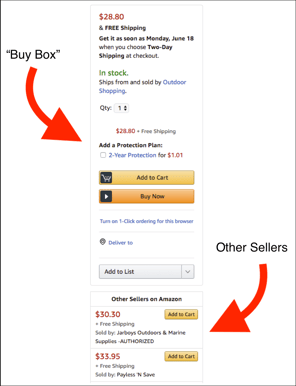.jpeg?width=300&name=AdobeStock_70869411%20(1).jpeg) Forrester Research has projected that by 2021, eCommerce will comprise 13.1% of all US B2B sales, with a compound annual growth rate of 7.4%. A while back, I wrote about eCommerce as the #1 way to grow your distribution business, and part of that conversation included establishing an effective eCommerce presence through 3rd party sites.
Forrester Research has projected that by 2021, eCommerce will comprise 13.1% of all US B2B sales, with a compound annual growth rate of 7.4%. A while back, I wrote about eCommerce as the #1 way to grow your distribution business, and part of that conversation included establishing an effective eCommerce presence through 3rd party sites.
It may surprise you to learn that the site with the most opportunity for major revenue boosts is Amazon. That’s right—the world’s number one retail mass marketplace might also be a profitable B2B sales channel for your distribution business.
If you can't beat 'em, join 'em.
I'll be candid: Amazon is a demanding place to sell, and shortly I'll get into how you can prepare for it. But first, the benefits of selling on Amazon:
- Amazon is the king of online marketplaces. Making upwards of $100 billion in revenue every year, the shopping website has a colossal lead over all its competitors.
- Their reach is unprecedented. Amazon dominates eCommerce browser activity like no other with a user-base of over 300 million. Selling on such a high-traffic channel means you’re casting a wider B2B net AND seizing an opportunity to enter into the enormous B2C space.
- Amazon Business is growing rapidly every year. More and more businesses—your customers—are attracted to buying via this one-stop-shop channel. The service hit the million-customer mark last July and only continues to gain trust and traction. In the same way that Amazon became the main hub for B2C sales, Amazon Business may very soon become the go-to for B2B commerce.
- Amazon is widely trusted by online shoppers. Customers around the world have seen first-hand the lengths Amazon goes to provide amazing customer service and fast delivery—no matter who the seller of the product is. Third-party sellers with Amazon’s trust (and a Prime badge—I’ll expand on that later) are also trusted by customers. Should you earn it, this automatic, reflexive faith can result in more sales for you.

- Amazon is a major market share opportunity. Depending on your line of business, you may discover that an Amazon sales channel is critical for maintaining or growing market share—and being first among your competitors in filling a market void.
It’s a jungle in there—so keep these survival tips in mind.
Thriving in the Amazon “jungle” starts with knowing the common pitfalls and how to take appropriate precautions to avoid them. Here are the most important things to keep in mind:
- Having a Prime badge on products means having Prime member trust. Prime members look for the Prime badge first. Without it, you’re just another needle in the haystack. There are two ways to become a Prime seller:
- FBA (Fulfilled by Amazon): The easiest way to gain eligibility for Prime is to pay a fee for Amazon to take care of all storage, shipping, and customer service logistics on your orders. These fees can add up depending on how much space your product takes up and how long it stays in the Amazon warehouse. Another downside to FBA status is having to let go of your control over warehouse processes.
- SFP (Seller-Fulfilled Prime): SFP is wonderful if you can meet the many requirements needed to qualify. With SFP, you retain the full capability of your own warehouse processes with total control over stocking, shipping, handling, and service. Plus, you avoid heavy fees and get to keep that shiny Prime badge.
- Amazon's A-Z guarantee program means any customer problems are resolved with your business as the bad guy—no matter the issue. When it comes to a dispute with a customer, you're guilty until proven innocent. At Amazon, the customer is always right—which means you’re going to have to work extra hard to make sure disputes don’t happen in the first place. On-time shipments and up-to-the-minute inventory tracking will be crucial components of your multi-channel framework if you want your Amazon reputation to remain stellar. And speaking of reputation.…
- Customer reviews are everything. Amazon consumers won’t typically buy a product with an average rating below three stars. The key here is owning “the moment that matters.” I’m referring to the time during which an order moves from the fulfillment center to its final destination. If you can ensure these moments go smoothly, you’ll find yourself building a loyal and steady customer base through Amazon. If you have consistent issues during this “last mile” moment, brace yourself for some less-than-stellar reviews.
- Product returns are free for the customer—which means they'll cost you. If you want to avoid returns, customers need to know that what they see is what they'll get. Clear product descriptions and professional photos are necessities in order to avoid any surprises when that box is finally opened at its destination. Your ROI here can be significant, so don’t take any short-cuts.
- You want to be in “the box.” When you offer the same product as another seller, Amazon’s algorithm decides which seller offers the best value for customers and puts them in the “Buy Box”—the place where a customer can actually start the buying process.

Note here the Buy Box for a Barton Marine 70200 – Midi “K” Cam Cleat, for which there are multiple sellers. The Box is bigger, more noticeable, and often seems like the only buying option to customers.
Winning the Buy Box will automatically give your product a significant advantage over competitors, so be sure to make it a priority.
A rewarding investment—if you do it right.
Adapting your business to sell directly to the consumer is a big step and your eCommerce framework will require considerable planning. But let’s face the facts: If you’re not selling on Amazon, then you face competing against them and losing market share. And if Amazon Business continues its rapid growth, your own B2B customers may start looking on Amazon before your website when they need to restock.
 Choosing to invest in this potentially profit-boosting opportunity means there are a lot of questions you’ll have to answer. Will you choose FBA over SFP and risk losing inventory control? How will you begin to qualify for SFP or the Buy Box? Are your order-tracking, shipping processes, and technology up to speed for these qualifications? How will you sustain a positive Amazon reputation?
Choosing to invest in this potentially profit-boosting opportunity means there are a lot of questions you’ll have to answer. Will you choose FBA over SFP and risk losing inventory control? How will you begin to qualify for SFP or the Buy Box? Are your order-tracking, shipping processes, and technology up to speed for these qualifications? How will you sustain a positive Amazon reputation?
If you’re considering Amazon as a B2B sales channel, hats off to you. And if you’re ready to commit to meeting their high expectations—getting you that SFP badge, putting you in “the box,” and reeling in those coveted positive reviews—let’s talk about how to get you there.





